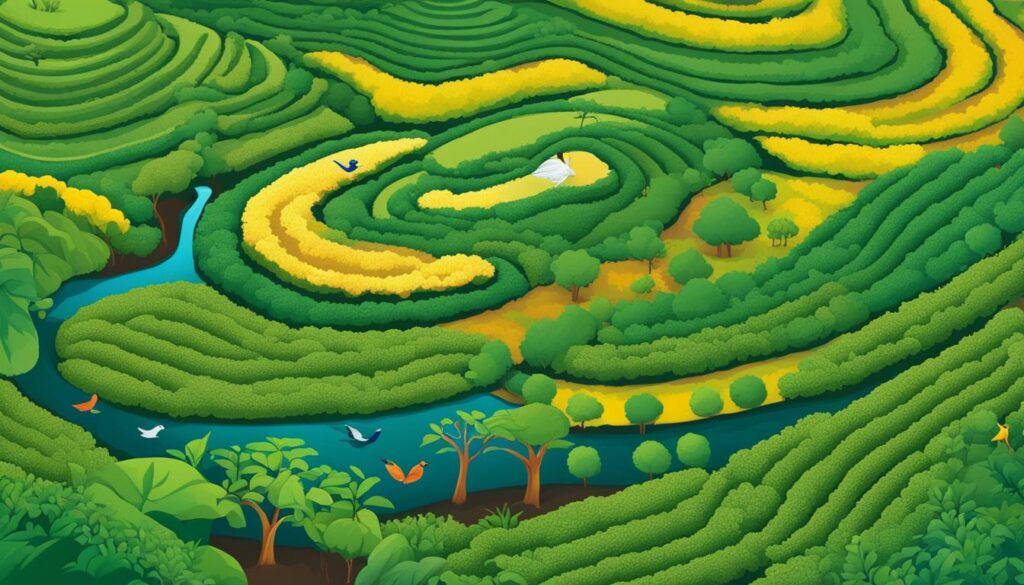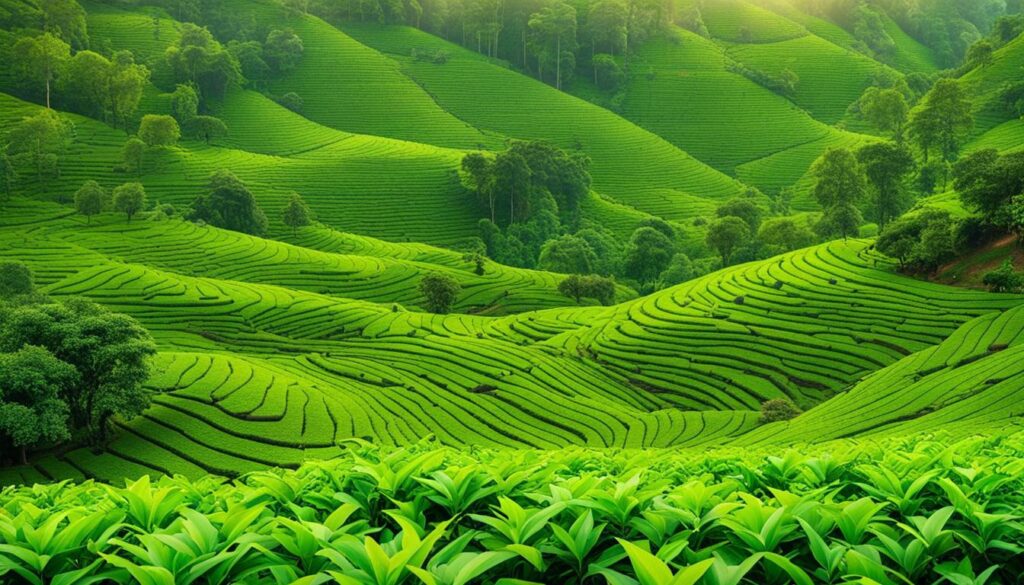Welcome to our exploration of the fascinating world of tea estates and their vital role in conserving biodiversity. From the incredible wildlife and flora found in tea gardens to the immersive tea plantation ecosystem tours, we’re here to shed light on the importance of preserving these precious ecosystems. Join us as we delve into the wonders of tea estate biodiversity and discover how sustainable practices can ensure the longevity of this cherished industry.
Key Takeaways:
- Tea estate biodiversity encompasses a diverse range of wildlife and flora found in tea gardens.
- Tea plantation ecosystem tours offer an opportunity to explore and appreciate the natural habitats within tea estates.
- Conserving biodiversity in tea estates is crucial for the long-term sustainability of the tea industry.
- Sustainable practices, such as organic farming and efficient water management, play a significant role in mitigating the environmental impact of tea production.
- Supporting BiodiversiTEA promotes the preservation of natural resources and biodiversity in tea estates.
The Environmental Impact of Tea Production
Tea production has significant implications for the environment, particularly in terms of biodiversity conservation. Tea farm biodiversity studies have revealed the challenges faced by tea gardens in maintaining a healthy ecosystem while meeting the demands of production. The expansion of tea plantations often leads to deforestation, causing the loss of vital habitats for numerous species. This not only disrupts the delicate balance of flora and fauna but also threatens the overall biodiversity of the region.
Tea garden conservation efforts play a crucial role in mitigating the negative impact of tea production on the environment. By implementing sustainable practices, tea producers can help preserve the delicate balance of tea plantation flora and fauna. This includes adopting organic farming methods that minimize the use of synthetic pesticides and fertilizers, reducing water consumption through efficient irrigation techniques, and promoting agroforestry to enhance biodiversity.
“The environmental impact of tea production extends beyond the tea estates themselves. Pesticide use in conventional tea farms can have detrimental effects on non-target organisms and can even pose risks to the health of workers and nearby communities.”
Tea plantation ecosystem tours offer visitors the opportunity to observe firsthand the diverse flora and fauna present in tea estates. These tours not only provide a unique experience but also raise awareness about the environmental challenges faced by the tea industry. Through education and engagement, individuals can contribute to the conservation of biodiversity in tea estates and support sustainable tea production practices.
| Environmental Impact | Conservation Efforts |
|---|---|
Deforestation
| Organic farming
|
Pesticide Use
| Efficient water management
|
Agroforestry
|
By recognizing the environmental impact of tea production and supporting conservation efforts, we can contribute to the sustainability of the tea industry and protect the natural resources and biodiversity found in tea estates. Let’s raise a cup of tea to a greener future!

Sustainable Practices in Tea Production
Tea production plays a significant role in global agriculture, but it is essential to ensure that it is carried out in a sustainable manner. By implementing sustainable practices, tea farmers can not only protect the environment but also preserve the delicate balance of biodiversity in tea estates. Here, we explore some of the key sustainable practices in tea production, highlighting their positive impact on tea farm environmental diversity.
1. Organic Farming: Organic farming methods minimize the use of synthetic pesticides and fertilizers, reducing the risk of harmful chemical runoff into water sources and protecting non-target organisms. Organic tea farms prioritize the health of the soil and ecosystem, nurturing a diverse range of flora and fauna within the tea estate. By choosing organic teas, consumers can support sustainable agriculture and promote the preservation of environmental diversity.
2. Agroforestry: The integration of trees in and around tea plantations is known as agroforestry. This practice not only provides shade for tea bushes but also creates additional habitats for wildlife. By planting native tree species, tea farmers can attract a variety of birds, insects, and small mammals to their estates, further enhancing tea garden ecological diversity.
| Sustainable Practices | Benefits |
|---|---|
| Organic Farming | Protects soil health, minimizes chemical runoff, and supports biodiversity |
| Agroforestry | Provides shade, additional wildlife habitats, and aids in soil conservation |
3. Water Management Techniques: Efficient water management is crucial in tea production, especially in regions facing water scarcity. Drip irrigation systems and rainwater harvesting help conserve water resources, reduce wastage, and promote sustainable tea farming. By implementing these techniques, tea farmers contribute to the overall conservation of water ecosystems.
Tea Garden Ecological Tours
“Tea plantation wildlife exploration allows visitors to witness the beauty of biodiversity in tea estates.”
Tea garden ecological tours offer a unique opportunity for visitors to immerse themselves in the natural wonders of tea estates. These tours provide insights into sustainable tea production practices, tea garden conservation efforts, and the diverse flora and fauna thriving within the tea estate ecosystem. By experiencing the beauty of biodiversity firsthand, visitors gain a deeper appreciation for the importance of sustainable tea production.
By embracing sustainable practices and supporting tea plantation wildlife exploration, we can foster a harmonious relationship between tea farming and the natural environment. Together, we have the power to contribute to the preservation of tea farm environmental diversity and ensure the long-term sustainability of the tea industry.

The Importance of Biodiversity Tea (BiodiversiTEA)
Biodiversity tea, also known as BiodiversiTEA, is not just a beverage; it represents a shift towards a new era of tea production that prioritizes biodiversity conservation in tea estates. With the looming threat of monoculture in the tea industry, BiodiversiTEA offers a promising alternative by integrating tea cultivation with the local ecology and preserving the habitats of various flora and fauna.
By supporting BiodiversiTEA, tea enthusiasts play a crucial role in preserving natural resources and promoting the conservation of biodiversity in tea estates. This sustainable approach to tea production not only helps maintain the delicate balance of ecosystems but also ensures the availability of high-quality tea for future generations.
Tea plantation wildlife exploration provides a unique opportunity for individuals to witness the wonders of nature thriving within tea estates. From vibrant bird species to elusive mammals, these ecosystems are teeming with life that thrives within the boundaries of sustainable tea production. With every sip of BiodiversiTEA, tea lovers can appreciate the harmony between human activity and the natural world.
The Dawn of A New Age of Tea Monoculture
“The era of tea monoculture can be detrimental to the environment and biodiversity,” warns Dr. Jane Greenleaf, a renowned biodiversity scientist. “Large-scale tea plantations often prioritize quantity over quality, leading to the destruction of crucial habitats and the loss of valuable plant and animal species.”
Without proper conservation efforts, tea monoculture can have far-reaching consequences. It not only threatens the diversity of flora and fauna but also disrupts the ecological balance, making tea estates more susceptible to pests and diseases. This, in turn, increases the reliance on synthetic pesticides and fertilizers, further exacerbating the environmental impact.
| BiodiversiTEA vs. Tea Monoculture | BiodiversiTEA | Tea Monoculture |
|---|---|---|
| Biodiversity Conservation | Preserves local ecology and habitats | Leads to habitat destruction |
| Environmental Impact | Minimal use of synthetic pesticides and fertilizers | Reliance on chemical inputs |
| Quality | High-quality teas with diverse flavors and aromas | Mass-produced teas with uniform taste profiles |
| Sustainability | Promotes long-term sustainability of the tea industry | May lead to environmental degradation |
As consumers, our choices matter. By embracing BiodiversiTEA, we can support sustainable tea production practices that prioritize biodiversity conservation. Together, we can embark on a journey towards a future where tea estates flourish with diverse ecosystems, providing us with not only a cup of tea but also a deeper connection to the natural world.
Addressing Environmental Concerns in Tea Production
Tea cultivation brings with it a set of environmental concerns that need to be carefully addressed in order to ensure the sustainability of the industry. One significant issue is the impact of deforestation on tea plantations, which results in the loss of crucial ecosystems and disrupts the rich biodiversity in these regions. Another concern is the use of pesticides in tea farms, which not only harms the environment but also poses risks to non-target organisms and the health of workers and nearby communities.
The water-intensive nature of tea cultivation and the energy-intensive processes involved in processing and packaging also contribute to environmental issues. To mitigate these concerns, it is essential to adopt sustainable practices in tea production that promote tea farm environmental diversity and manage resources efficiently. By implementing organic farming techniques, minimizing pesticide use, and integrating trees and vegetation in and around tea plantations, it is possible to preserve biodiversity and minimize the environmental impact.
Conclusion
As we conclude our exploration of the conservation of biodiversity in tea estates, it is evident that sustainable practices and BiodiversiTEA play a crucial role in addressing the environmental impact of tea production. By embracing tea plantation ecosystem tours and tea plantation wildlife exploration, we can gain a deeper understanding of the importance of preserving tea estate biodiversity.
Through the adoption of organic farming, agroforestry, and efficient water management techniques, we can mitigate deforestation, pesticide use, and water consumption in tea cultivation. These practices not only benefit the environment but also contribute to the diverse flora and fauna thriving in tea estates.
By making informed choices and supporting BiodiversiTEA, we are actively contributing to the long-term sustainability of the tea industry and the preservation of natural resources. So let’s raise our cups to the wonders of tea plantation ecosystem tours, and together, let’s continue to cherish the beauty and conservation of tea estate biodiversity.
FAQ
What is tea estate biodiversity?
Tea estate biodiversity refers to the variety of wildlife and flora that exist within a tea plantation ecosystem.
How can I explore tea estate biodiversity?
You can explore tea estate biodiversity through tea plantation ecosystem tours and tea estate natural habitat exploration.
What are the environmental consequences of tea production?
The environmental consequences of tea production include deforestation, pesticide use, and water and energy consumption.
How can tea garden conservation efforts mitigate the environmental impact?
Tea garden conservation efforts can mitigate the environmental impact by adopting sustainable practices such as organic farming and agroforestry, and implementing efficient water management techniques.
What is BiodiversiTEA?
BiodiversiTEA refers to teas that are grown in a way that integrates with the local ecology and wildlife, preserving the surrounding environment and habitats.
How can supporting BiodiversiTEA contribute to biodiversity conservation?
Supporting BiodiversiTEA can contribute to biodiversity conservation by preserving natural resources, promoting the conservation of biodiversity in tea estates, and enjoying high-quality tea.
What are some sustainable practices in tea production?
Some sustainable practices in tea production include organic farming, agroforestry, efficient water management, fair trade certification, and the use of sustainable packaging alternatives and carbon offsetting programs.
How can tea plantation ecosystem tours educate individuals about biodiversity conservation?
Tea plantation ecosystem tours provide a unique opportunity to observe the diverse flora and fauna in tea estates, helping individuals understand the importance of biodiversity conservation.
How can we ensure the preservation of tea estate biodiversity?
By making informed choices, embracing sustainable alternatives, and supporting initiatives like BiodiversiTEA, we can ensure the preservation of tea estate biodiversity for future generations to enjoy.





